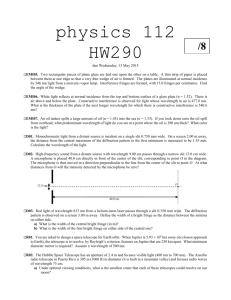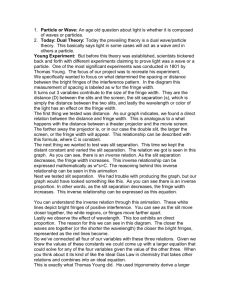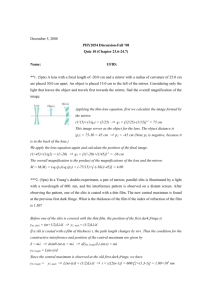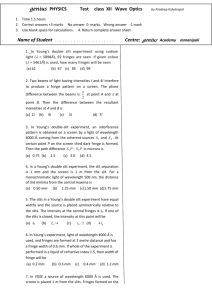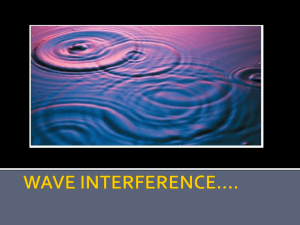File
advertisement
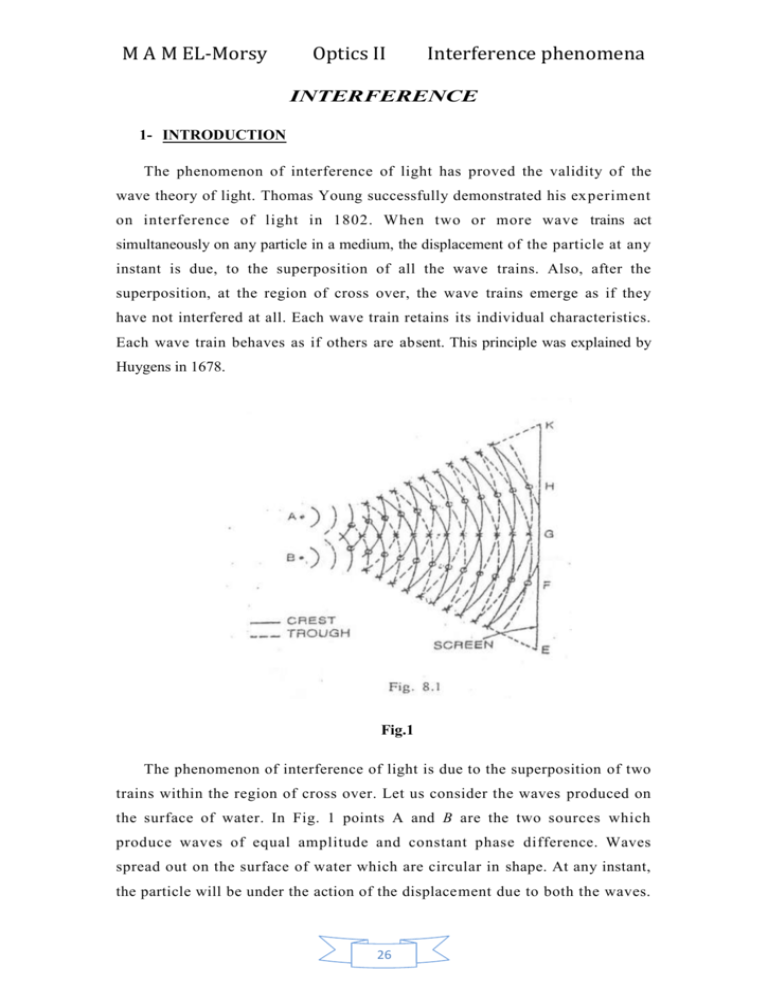
M A M EL-Morsy Optics II Interference phenomena INTERFERENCE 1- INTRODUCTION The phenomenon of interference of light has proved the validity of the wave theory of light. Thomas Young successfully demonstrated his ex periment on interference of light in 1802. When two or more wave trains act simultaneously on any particle in a medium, the displacement of the particle at any instant is due, to the superposition of all the wave trains. Also, after the superposition, at the region of cross over, the wave trains emerge as if they have not interfered at all. Each wave train retains its individual characteristics. Each wave train behaves as if others are absent. This principle was explained by Huygens in 1678. Fig.1 The phenomenon of interference of light is due to the superposition of two trains within the region of cross over. Let us consider the waves produced on the surface of water. In Fig. 1 points A and B are the two sources which produce waves of equal amplitude and constant phase difference. Waves spread out on the surface of water which are circular in shape. At any instant, the particle will be under the action of the displacement due to both the waves. 26 M A M EL-Morsy Optics II Interference phenomena The points shown by circles in the diagram will have minimum displacement because the crest of one wave falls on the trough of the other and the resultant displacement is zero. The points shown by crosses in the diagram will have maximum displacement because, either the crest of one will combine with the crest of the other or the trough of one will combine with the trough of the other. In such a case, the amplitude of the displacement is twice the amplitude of either of the waves-. Therefore, at these points the waves reinforce with each other. As the intensity (energy) is directly proportional to the square of the amplitude (I A2 ) the intensity at these points is four times the intensity due to one wave, It should be remembered that there is no loss of energy due to interference. The energy is only transferred from the points of minimum displacement to the points of maximum displacement. 2- YOUNG'S EXPERIMENT In the year 1802, Young demonstrated the experiment on the inter ference of light. He allowed sunlight to fall on a pinhole S and then at some distance away on two pinholes A and B (Fig.2). Fig. 2 27 M A M EL-Morsy Optics II Interference phenomena A and B are equidistant from S and are close to each other. Spherical waves spread out from S. Spherical waves also spread out from A and B. These waves are of the same amplitude and wavelength. On the screen interference bands are produced which are alternatively dark and bright. The points such as E are bright because the crest due to one wave co incides with the crest due to. the other and therefore they reinforce with each other. The points such as F are dark because the crest of one falls on the trough of the other and they neutralize the effect of each other. Points, similar to E, where the trough of one falls on the trough of the other, are also bright because the two waves reinforce. It is not possible to show interference due to two independent sources of light, because a large number of difficulties are involved. The two sources may emit light waves of largely different ampl itude and wavelength and the phase difference between the two may change with time. 3- COHERENT SOURCES Two sources are said to be coherent if they emit light waves of the same frequency, nearly the same amplitude and are always in phase with each other. It means that the two sources must emit radiations of the same colour (wavelength). In actual practice it is not possible to have two ' independent sources which are coherent. But for experimental purposes, two virtual sources formed from a single source can act as coherent sources. Methods have been devised where (i) interference of light takes place between the waves from the real source and a virtual source (ii) interference of light takes place between waves from two sources formed due to a single source. In all such cases, the two sources will act, as if they are per fectly similar in all respects. Since the wavelength of light waves is extremely small (of the order of 10-5 cm), the two sources must be narrow and must also be close to each other. Maximum intensity is observed at a point where the phase dif ference between the two waves reaching the point is a whole number mul tiple of 2 or the path difference between the two waves is a whole number multiple of wavelength. For minimum intensity at a point, the phase difference 28 M A M EL-Morsy Optics II Interference phenomena between the two waves reaching the point should be an odd number multiple of or the path difference between the two waves should be an odd number multiple of half wavelength. 4- PHASE DIFFERENCE AND PATH DIFFERENCE If the path difference between the two waves is , the phase difference = 2. Suppose for a path difference x, the phase difference is For a path difference , the phase difference = 2 5- ANALYTICAL TREATMENT OF INTERFERENCE Consider a monochromatic source of light S emitting waves of wavelength , and two narrow pinholes A and B (Fig.3). A and B are equidistant from S and act as two virtual coherent sources. Let a be the amplitude of the waves. The phase difference between the two waves reaching the point P, at any instant., is Fig. 3 29 M A M EL-Morsy Optics II Interference phenomena intensity is maximum when the phase difference is a whole number multiple of 2. or path difference is whole number multiple of wavelength. (ii) When the phase difference, = , 3 , ….(2n+1) , or the path Difference x = 2 , 3 5 , , ........ 2 n 1 2 2 2 I =0 30 M A M EL-Morsy Optics II Interference phenomena Intensity is minimum when the path difference is an odd number multiple of half wavelength. (ii) Energy distribution. From equation (iv), it is found that the intensity at bright points is 4a2 and at dark points it is zero. According to the law of conservation of energy, the energy cannot be destroyed. Here also the energy is not destroyed but only transferred from the points of minimum intensity to the points of maximum intensity. For, at bright points, the intensity due to the two waves should be 2a 2 but actually it is 4a ) . As shown in Fig. 4 the intensity varies from 0 to 4a 2 , and the average is still 2:2 2 . It is equal to the uniform intensity 2a 2 which will be present in the absence of the interference phenomenon due to the two waves. Therefore, the formation of interference fringes is in accordance with the law of conservation of energy. Fig. 4 6- THEORY OF INTERFERENCE FRINGES Consider a narrow monochromatic source S and two pinholes A and B, equidistant from S. A and B act as two coherent sources separated by a distance d. Let a screen be placed at a distance D from the coherent sources. The point C on the screen is equidistant from A and B. Therefore, the path difference between the two waves is zero. Thus, the point C has maximum intensity. 31 M A M EL-Morsy Optics II Interference phenomena Consider a point P at a distance x from C. the waves reach at the 'point P from A and B. (i) Bright fringes. If the path difference is a whole number multiple of wavelength , the point P is bright This equation gives the distances of the bright fringes from the point C. At C, the path difference is zero and a bright fringe is formed. 32 M A M EL-Morsy Optics II Interference phenomena (ii) Dark fringes. If the path difference is an odd number multiple of half wavelength the point P is dark The distance between any two consecutive dark fringes, x 2 x1 5 D 3 D D 2d 2d d (vi) The distance between any two consecutive bright or dark fringes is known as fringe width. Therefore, alternately bright and dark parallel fringes are formed. The fringes are formed on both sides of C. Moreover, from equations (v) and (vi), it is clear that the width of the bright fringe is equal to the width of the dark fringe. All the fringes are equal in width and are independent of the order of the fringe. The breadth of a bright or a dark 33 M A M EL-Morsy Optics II Interference phenomena D fringe is, however, equal to half the fringe width and is equal 2 d The fringe width D d Therefore, (i) the width of the fringe is directly proportional to the wavelength of light, , (ii) The width of the fringe is directly proportional to the distance of the screen from the two sources, D, (iii) the width of the fringe is inversely proportional to the distance between the two sources, 1 d . Thus, the width of the fringe increases (a) with increase in wavelength (b) with increase in the distance D and (c) by bringing the two sources A and B close to each other. Example1. Green light of wavelength 5100 A from a narrow slit is incident on a double slit. If the overall separation of 10 fringes on a screen 200 cm away is 2 cm. find the slit separation. Example 2 Two coherent sources are 0.18 mm apart and the fringes are observed on a screen 80 cm away It is found that with a certain monochromatic source of light, the fourth bright fringe is 34 M A M EL-Morsy Optics II Interference phenomena situated at a distance of 10.8 mm from the central fringe. Calculate the wavelength of light. Example 3 In Young's double slit experiment the separation of the slits is 1.9 mm and the fringe spacing is 0.31 mm at a distance -of 1 metre from the slits. Calculate the wavelength of light. Example 4 Two straight and narrow parallel slits 1 mm apart are illuminated by monochromatic light. Fringes formed on the screen held at a distance of 100 cm from the slits are 0.50 mm apart. What is the wavelength of light ? 35 M A M EL-Morsy Optics II Interference phenomena Example 5 A Young's double slit experiment is arranged such that the distance between the centers of the two slits is d and the source slit, emitting light of wavelength , is placed at a distance x from the double slit. If now the source slit is gradually opened up, for what width will the fringes first disappear ? A and B are two extreme points of the source S separated by distance L The fringe pattern first disappears when the central maximum of one pattern overlaps on the first minimum of the second pattern. The first minimum occurs at distance given by 36 M A M EL-Morsy Optics II Interference phenomena The fringe width is very large when d is very small. As d increases, the first minimum of S1 , moves towards the zeroeth maximum of S 2 . These two meet when d = do Example 6 A light source emits light of two wavelengths 4300 A and X2 = 5100A. The source is used in a double slit interference experiment. The distance between the sources and the screen is 1.5 m and the distance between the slits is 0.025 mm. Calculate the separation between the third order bright fringes due to these two wave. 37 M A M EL-Morsy Optics II Interference phenomena Hence, the separation between the two fringes is 1.44 cm. Example 7 Two coherent sources of monochromatic light of wavelength 6000 A produce an interference pattern on a screen kept at a distance of I m from them. The distance between two consecutive bright fringes on the screen is 0.5 mm. Find the distance between the two coherent sources. 38 M A M EL-Morsy Optics II Interference phenomena Example 8 Light of wavelength 5500 A from a narrow slit is in cident on a double slit. The overall separation of 5 fringes on a screen 200 cm away is 1 cm, calculate (a) the slit separation and (b) the fringe width. 39 M A M EL-Morsy Optics II Interference phenomena 7- FRFSNEL ' S MIRRORS Fresnel produced the interference fringes by using two plane mirrors M and M 2 arranged at an angle of nearly 180° so that their surfaces are nearly (not exactly) coplanar (Fig. 8.7). A monochromatic source of light S is used. The pencil of light from S incident on the two mirrors, after reflection appears to come from two virtual sources A and B at some distance d apart. Therefore, A and B act as two virtual coherent sources and interference fringes are obtained on the screen. These fringes are of equal width and are alternately dark and bright. Theory. A and B are two coherent sources at a distance d apart. The screen is at a distance D from the virtual sources. The two reflected beams from the mirrors M1 and M2 overlap between E and F (shown as shaded in the diagram) and interference fringes are formed. Here, D =Y 1 + Y 2 Fri nge wi dt h D d A point on the screen will be at the centre of a bright fringe, if its distance from C is n D where n = 0, 1, 2, 3 etc, and it will be at the centre of a dark fringe, d if its distance from C. is 2 n 1 D where n = 0, 1, 2, 2 d . . . etc. For the fringes to be formed, the following conditions must be sat isfied. 40 M A M EL-Morsy Optics II Interference phenomena The two mirrors M1 and M, should be made from optically flat glass and silvered on the front surfaces. No reflection should take place from the back of the mirrors. The polishing should extend up to the line of intersection of the two mirrors and the line of intersection must be parallel to the line source (slit). The distance between the two virtual sources A and B can be calculated as follows. Suppose the distance between the points of intersection of the mirrors and the source S is Y1 is known. The angle of separation between A and B is 2. d = 2 yl When white light is used the central fringe C is white whereas the other fringes on both sides of C are coloured because the fringe width 03) depends upon the wavelength. Only the first few coloured fringes are observed and the other fringes overlap. Therefore; the number of fringes seen in the field of view with a monochromatic source of light are more, than with white light. 8- FRESNEL'S BIPRISM Fresnel used biprism to show interference phenomenon. Tut biprism abc consists of two acute angled prisms placed base to base. Ac tually, it is constructed as a single prism of obtuse angle of about 179° (Fig. 8.7A). The acute angle on both sides is about 30'. The prism is placed with its refracting edge parallel to the line source S (slit) such that 41 M A M EL-Morsy Optics II Interference phenomena Sa is normal to the face bc of the prism. When light falls from S on the lower portion of the biprism it is bent upwards and appears to come from The virtual source B. Similarly light falling from S on the upper portion of the prism is bent downwards and appears 'to come from the virtual source A. Therefore A and B act as two coherent sources. Suppose the distance between A and B = d. If a screen is placed at C, interference fringes of equal width are produced between E and F but beyond E and F fringes of large width are produced which are due to diffraction. MN is a stop to limit the rays. To observe the fringes, the screen can be re placed by an eye-piece or a low power microscope and fringes are seen in the field of view. If the point C is at the principal focus of the eyepiece, the fringes are observed in the field of view. Theory. For complete theory refer to Article 8.6. The point C is equidistant from A and B. Therefore, it has maximum intensity. On both sides of C, alternately bright and dark fringes are produced. The width of the bright fringe or dark fringe, D d . Moreover, any point on the screen will be at the cent re of a bri ght fri nge if its dist ance from C is n D , where n = 0, 1, 2, 3 etc. The point will be at the centre of a d dark fringe if its distance from C is 2 n 1 D , where n = 0, 1, 2, 3 etc. 2 d Determination of wavelength of light. Fresnel's biprism can be used to determine the wavelength of a given source of monochromatic light. A fine vertical slit S is adjusted just close to a source of light and the refracting edge is also set parallel to the slit S such that be is horizontal (Fig. 8.8). They are adjusted on an optical bench. A micrometer eyepiece is placed on the optical bench at some distance from the prism to view the fringes in its focal plane (at its cross wires). 42 M A M EL-Morsy Optics II Interference phenomena Suppose the distance between the source and the eyepiece = D and the distance between the two virtual sources A and B d. The eyepiece is moved horizontally (perpendicular to the length of the bench) to determine the fringe width. Suppose, for crossing 20 bright fringes from the In equation (i) and D are known. If d is also known, can be calculated. Determination of the distance between the two virtual sources (d). For this purpose, we make use of the displacement method. A convex lens is placed between the biprism and the eyepiece in such a position, that 43 M A M EL-Morsy Optics II Interference phenomena the images of the virtual sources A and B are seen in the field of view of the eyepiece. Suppose the lens is in the position L 1 (Fig. 8.9). Measure the distance between the images of A and B as seen in the eyepiece. Let it be d1 In this vase , d1 v n d u m (ii ) Now move the lens towards the eyepiece and bring it to some other position L2, so that again the images of A and B are seen clearly in the field of view of the eyepiece. Measure the distance between the two im ages in this case also. Let it be equal to d2 Here d 1 will be greater than d 2 and d is the geometrical mean of d1 and d 2 . Therefore d can be calculated . Substituting the value of d, and D in equation (i), the wavelength of the given monoch r omatic light can be determined, The second method to find d is to measure accurately the refracting angle . As the an g le is small, the deviation produced 1 . Therefore the total angle between Aa and Ba is 2 2 1 . the is distance d 2 1 between the prism and the y1 . Therefore d can be calculated. 44 slit S y1 If then M A M EL-Morsy Optics II Interference phenomena 9- FRINGES WITH WHITE LIGHT USING A BIPRISN When white light is used, the centre of the fringe at C is white while the fringes on both sides of C are coloured because the fringe width ( ) depends upon wavelength. Moreover, the fringes obtained in the case of a biprism using white light are different from the fringes obtained with Fresnel's mirrors. In a biprism, the two coherent virtual sources are pro duced by refraction and the distance between' the two sources depends upon the refractive index, which in turn depends upon the wavelength of light. Therefore, for blue light the distance between the two apparent sources is different to that with red light. The distance of the n th fringe from the centre (with monochromatic light) Example 9 A biprism is placed 5 cm from a slit illuminated by sodium light ( = 5890 A). The width of the fringes obtained on a screen 75 cm from the biprism is 9.424 x 10 -2 cm. What is the distance between the Iwo coherent sources ? 45 M A M EL-Morsy Optics II Interference phenomena Example 10 The inclined faces of a glass prism (k = 1.5) make an angle of 1° with the base of the prism. The slit is 10 cm from the biprism and is illuminated by light of = 5900 A. Find the fringe width observed at a distance of I m from the biprism. Example 11 In a biprism experiment with sodium light, bands of width 0.0195 cm are observed at 100 cm from the slit. On introducing a convex lens 30 cm away from the slit, two images of the slit are seen 0.7 cm apart, at 100 cm distance from the slit. Calculate the wavelength of the sodium light. 46 M A M EL-Morsy Optics II Interference phenomena Example 12 Interference fringes are observed with a biprism of refracting angle 1° and refractive index 1.5 on a screen 80 cm away from it. If the distance between the source and the biprism is 20 cm, calculate the fringe width when the wavelength of light used is (i) 6900 A and (ii) 5890 A. 47 M A M EL-Morsy Optics II Interference phenomena Example 13 A biprism is placed at a distance of 5 cm in front of. a narrow slit, illuminated by sodium light ( = 5890 x 10 -8 cm) and the distance between the virtual sources is found to be 0.05 cm. Find the width of the fringes observed in an eyepiece placed at a distance of 75 cm from the biprism. Example 14 In a biprism experiment the eyepiece was placed at a distance of 120 cm from the source. The distance between the two virtual sources was found to be 0.075 cm. Find the wavelength of light of the source if the eyepiece has to be moved through a distance 1.888 cm for 20 fringes to cross the field of view. Example 15 In an experiment with Fresnel's biprism, fringes for light of wavelength 5 x 10 -5 cm are observed 0.2 mm apart at a distance of 175 cm from the prism. The prism is made of glass of refractive index 1.50 and it is at a distance of 25 cm from the illuminated slit. Calculate the angle at the vertex of the biprism. 48 M A M EL-Morsy Optics II Interference phenomena Example 16 Calculate the separation between the coherent sources formed by a biprism whose inclined faces make angles of I degree with its base. The slit source is 20 cm away from the biprism and µ. of the biprism material = 1.5. 49 M A M EL-Morsy Optics II Interference phenomena Example 17 Calculate the separation between the coherent sources formed by a biprism whose inclined faces make angles of 2° with i t s b a s e , t h e s l i t s o u r c e b e i n g 1 0 c m a w a y f r o m t h e b i p r i s m ( µ= 1.50.) Example 18 In a biprism experiment, the. eyepiece is placed at a distance of 1.2 m form the source. The distance between the virtual sources was found to be 7.5 x 10-4 in. Find the wavelength of light, if the eyepiece is to be moved transversely through a distance of 1.888 cm for 20 fringes. 50 M A M EL-Morsy Optics II Interference phenomena Example 19 The inclined faces of a biprism of refractive index 1.50 make angle of 2 0 with the base. A slit illuminated by a monochromatic light is placed at a distance of 10 cm from the biprism. If the distance between two dark fringes observed at a distance of 1 cm from the prism is 0.18 mm, find the wavelength of light used. 10- DETERMINATION OF THE THICKNESS OF A THIN SHEET OF TRANSPARENT MATERIAL The biprism experiment can be used to determine the thickness of a given thin sheet of transparent material e.g., glass or mica. Suppose A and B are two virtual coherent sources. The point C is equidistant from A and B. When a transparent plate G of thickness t and refractive index p. is introduced in the path of one of the beams (Fig. 8.10), the fringe which was originally at C shifts to P. The time taken by the wave from B to P in air is the same as the time taken by the wave from A to P partly through air and partly through the plate. 51 M A M EL-Morsy Optics II Interference phenomena Suppose c o is the velocity of light in air and c its velocity in the medium If P is the point originally occupied by the n th fringe, then the path difference BP— AP = n (µ— 1) t = n . ...(i) Also the distance x through which the fringe is shifted where D d n D d , the fringe width x n D d also , n xd D or 1 t xd D (ii ) Therefore, knowing x, the distance through which ,the central fringe is 52 M A M EL-Morsy Optics II Interference phenomena shifted, D, d and µ, the thickness of the transparent plate can be calculated. If a monochromatic source of light is used, the fringes will be similar and it is difficult to locate the position where the central fringe shifts after the introduction of the transparent plate. Therefore, white light is used. The fringes will be coloured but the central fringe will be white. When the cross wire is at the central white fringe without the transparent plate in the path, the reading is noted. When the plate is introduced, the 'position to which the central white fringe shifts is observed. The difference between the two positions on the micrometer scale of the eyepiece gives the value of the shift which is equal to x. Now, with the monochromatic source of light, the micrometer eyepiece is moved through the same dist a n c e x a n d t h e n u m b e r o f f r i n g e s t h a t c r o s s t h e f i e l d o f v i e w i s o b s e r v e d . Suppose n fringes cross the field of view. Then from the relation (µ— 1) t = n the value of t can be calculated. The value of t can also he calculated from equation (ii). However, if t is known, p. can be calculated. This experiment also shows that light travels more slowly in a me dium of refractive index µ > 1, than in air because the central fringe shifts towards the side where the transparent plate is introduced. Had it been opposite; the shift should have been to the other side. The Optical path in air = µ x t, for a medium of thickness t and refractive index µ. Example 20 When a thin piece of glass 3.4 x . 10 -!. cm thick is placed in the path of one of the interfering beams in a biprism arrange ment, it is found that the central bright fringe shifts through a distance equal to the width of four fringes. Find the refractive in dex of the piece of glass. Wavelength of light used is 5,46 x 10-5 .cm Here 53 M A M EL-Morsy Optics II Interference phenomena t 3.4 x 10 4 cm n 4 546 x 10 5 cm ? 1 t n n 1 0.6424 1 1.6424 t Example 21 Fringes are produced with monochromatic light of = 5450 A. A thin plate of glass of µ = 1.5 is then placed normally in the path of one of the interfering beams and the central band of the fringe system is found to move into the position previously occupied by the third bright band from the centre. Calculate the thickness of the glass plate. = 0.000237 Example 22 A transparent plate of thickness 10 -3 cm is placed in the path of one of the interfering beams of a biprism experiment using light of wavelength 5000 A. If the central fringe shifts by a distance equal to the width of ten fringes, calculate refractive index of the material of the plate. Example 23 A thin sheet of a transparent material (µD= 1.60) is placed in the path of one of the interfering beams in a biprism experiment usingsodium light, = 5890 x 10 -8 cm. The central fringe shifts to a 54 M A M EL-Morsy Optics II Interference phenomena position originally occupied by the 12 th bright fringe. Calculate the thickness of the sheet. Example 24 When a thin sheet of transparent material of thickness 6.3 x 10 -4 cm is introduced in the path of one of the interfering beams, the central fringe shifts to a position occupied by the sixth bright fringe. If = 5460 A, find the refractive index of the sheet. E xa mp l e 2 5 O n pl a ci n g a t h i n s h ee t o f m i c a o f t hi ck n ess 12 x 10 - 3 cm in the path of one of the interfering beams in a biprism arrangement, it is found that the central. bright band shifts a distance equal to the width of a bright fringe. Calculate the refractive index of mica [ = 6 x 10' s cm] Example 26 Fresnel's fringes are produced with homogeneous light of wavelength 6 x 10 -3 cm. A thin glass film (µ = 1.50) is interposed in the path of one of the interfering beams. The central bright band is shifted to the 55 M A M EL-Morsy Optics II Interference phenomena position previously occupied by the 5 th bright band. Find the thickness of the film. 11- LLOYD'S SINGLE MIRROR This experiment for the production of interference fringes was performed by Lloyd in 1834. He used a plane mirror about 30 cm in length and 6 to 8 cm in breadth (Fig. 8.11). The mirror M is either a flat polished metal or a piece of black glass so that no reflection takes place from the back of the mirror. S is a source of monochromatic light and B is the image of S formed by reflection. S corresponds to one of the coherent sources (viz. A). Hence S and B are very close and the rays from S are reflected: almost at grazing incidence. Interference fringes are produced on the screen placed at a distance D from S in the shaded portion EF. For complete theory refer to Article 8.6. But there is one difference in this case. The central fringe, instead of being bright is dark: If the screen is brought at the end R of the mirror M, such that the point C of the screen touches the end of the mirror, C comes at the centre of the dark fringe. C is equidistant from A and B. According to the theory it should lie at the centre of a bright fringe. Here, one of the two beams, producing interference fringes, has undergone a phase change of . The direct beam from S cannot undergo a phase change. Therefore, only the reflected beam undergoes a phase change of . Due to this reason, the central fringe instead of being white is dark in this case. This experiment proves that a light beam after reflection from an optically denser medium undergoes a phase change of . 56 M A M EL-Morsy Optics II Interference phenomena Fig. 8.11 Lloyd's Single Mirror One objection can be raised here, as to why the central fringe in the case of Frensnel's double mirror is bright and not dark. In the case of Fresnel's double mirror both the interfering beams are reflected and both undergo a phase change of . Therefore, the path difference is not altered as in the case of Lloyd's single mirror. Example 8.27: In a Lloyd's single mirror experiment, the distance between the slit source and its image is 5 mm. The screen is at a distance of 1 m. from the source. The fringe width is observed to be 0.1092 mm. Calculate the wavelength of light used. Example 8.28. In Lloyd's single mirror: interference experiment, the slit source is at a distance of 2 mm from the plane of the mirror. The screen is kept at a distance of 1.5 m from the source, Calculate the fringe witdh , the wavelength of light = 5890 A. 57 M A M EL-Morsy Optics II Interference phenomena 12- BILLET'S SPLIT LENS This, is a convenient device for producing interference fringes. It consists of a converging lens divided into two equal parts L1 and L2 (Fig. 8.12 ) L1 and L 2 , are coplanar and can be separated by a micrometer screw arrangement as desired. S is a monochromatic source of light and A and B are two real images of S formed by L1 and L, respectively. Interference fringes are formed between E and F (shaded portion on the screen). The point C equidistant from A and B lies at the centre of a bright fringe. Alternately bright and dark fringes are observed in the field of view. 58

